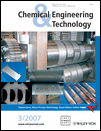Inline Analysis in Microreaction Technology: A Suitable Tool for Process Screening and Optimization
Abstract
A procedure is described for successfully benchmarking different inline spectroscopic techniques in a microreaction plant. The objective was to identify the highest calibration precision for the real-time quantification of the main product. Investigated methods were Raman-, near infrared-, and visible spectroscopy. Besides microreaction technology, the procedure comprises chemometric approaches using statistical experimental design tools and multivariate calibration methods. A calibration model was set up and validated within a defined parameter space (temperature, stoichiometry, and flow rate). The experimental basis was the investigation of toluene nitration using two different nitrating agents. The first reaction was a homogeneous nitration with pure nitric acid as the nitrating agent. It was found that Raman-spectroscopy generates the highest precision. In the second reaction, a heterogeneous liquid-liquid system was obtained using mixed acids. In this case, the precision is very similar for all methods with no preferences for a specific method. As well as investigating the calibration model, additional testing of the observed flow patterns was undertaken for the latter reaction, using the sensitive and very fast AOTF-NIR-spectroscopy.




